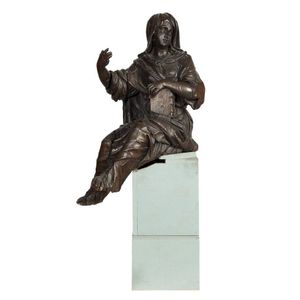Chinese Boxwood Carving of Hehe Erxian, Qing Dynasty
A Chinese boxwood carving of the Hehe Erxian, Qing Dynasty (1644-1912), 18th/19th century, the two seated boys carving resting on a separate fitted in the form of an unfurled plantain leaf. Together with a fitted Chinese silk brocade box. Provenance: the de Voogd collection, 11 cm high, 16 cm wide. Condition: the hand held aloft with the index finger broken off, the arm once separate shows evidence of being glued in place. Minor chips to edges of stand. Approximately 912 gm total weight with box.
You must be a subscriber, and be logged in to view price and dealer details.
Subscribe Now to view actual auction price for this item
When you subscribe, you have the option of setting the currency in which to display prices to $Au, $US, $NZ or Stg.
This item has been sold, and the description, image and price are for reference purposes only.
- Ming Dynasty - The Ming Dynasty was a ruling dynasty of China from 1368 to 1644. It succeeded the Yuan Dynasty and preceded the Qing Dynasty. The Ming Dynasty was established by Zhu Yuanzhang, a former Buddhist monk who became a rebel leader and eventually overthrew the Mongol Yuan Dynasty. During the Ming Dynasty, China experienced a period of relative stability and prosperity. The government was centralized and bureaucratic, with the emperor at the top of the hierarchy. The Ming Dynasty is known for its cultural achievements, including the development of porcelain, the invention of movable type printing, and the construction of the Great Wall of China.
- Qing Dynasty - The Qing Dynasty was the last imperial dynasty of China, ruling from 1644 to 1912. It was established by the Manchu people, who originated from the northeastern region of China. The Qing Dynasty was preceded by the Ming Dynasty and followed by the Republic of China.
- Boxwood - Boxwood is a hard, yellow coloured, close grained timber. In the 19th century it was often used for inlays, especially stringing, because of its contrasting colour to the darker timbers of the carcase. Stringing is the inlay of a narrow strip of veneer of a lighter colour, such as boxwood along or close to the edges of an object that has been veneered in a darker timber such as mahogany.
Because of its fine grain and resistnce to splitting or chipping it has also been used for treen, turnings, carvings and other small wooden items, such as chess pieces.
This item has been included into following indexes:
Visually similar items

A Chinese brass figure of Guan Yin atop a Shi Shi. Height 13 cm
Sold by
in
for
You can display prices in $Au, $US, $NZ or Stg.

A Chinese bronze ding formed censer & figure of Guanyin. 20th century. The figure 23 cm high (2)
Sold by
in
for
You can display prices in $Au, $US, $NZ or Stg.

A large and an impressive pair of carved oak figures, Flemish, 17th century, one of St. Rose and another female saint, 132 cm high. Provenance: Property of a Gentleman, New South Wales
Sold by
in
for
You can display prices in $Au, $US, $NZ or Stg.

Royal Doulton 'Pride & Joy' figure HN2945, height 18 cm
Sold by
in
for
You can display prices in $Au, $US, $NZ or Stg.
